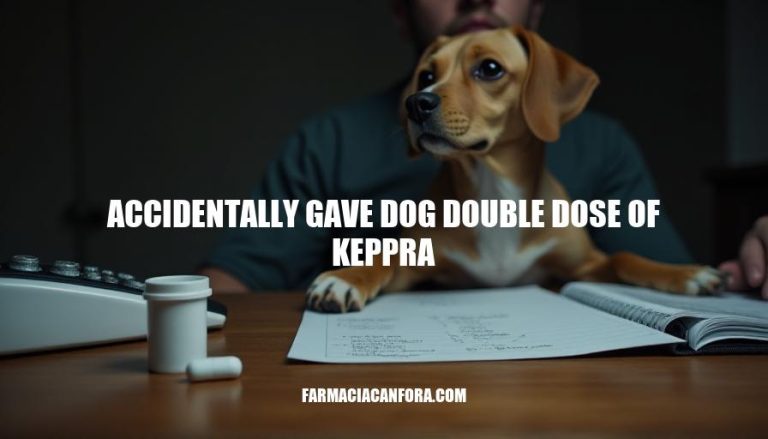Accidentally giving your dog a double dose of Keppra, an anticonvulsant medication, can be concerning. While Keppra generally has a wide margin of safety, it’s crucial to understand the potential risks and take immediate steps to ensure your pet’s well-being. If this happens, monitor your dog for any unusual symptoms such as drowsiness, loss of appetite, or vomiting. Contact your veterinarian promptly for guidance on how to proceed and to prevent any adverse effects.
Understanding Keppra
Keppra, also known as levetiracetam, is an anticonvulsant medication used in veterinary medicine to treat seizures in dogs and cats. It is often prescribed for dogs to manage epilepsy and other seizure disorders. Keppra is favored because it has minimal side effects and does not require liver metabolism, making it safer for dogs with liver issues. It can be used alone or in combination with other seizure medications to enhance effectiveness.
Potential Risks of Double Dosing
Accidentally giving a dog a double dose of Keppra (levetiracetam) can lead to several potential risks and side effects. Here are the key points to consider:
Potential Risks and Side Effects
- Sedation and Drowsiness: The most common side effect is increased sleepiness.
- Incoordination: Dogs may exhibit unsteady gait or difficulty walking.
- Gastrointestinal Issues: Nausea and vomiting can occur.
- Behavioral Changes: Sudden changes in behavior, such as increased agitation or lethargy.
Symptoms to Watch For
- Excessive sleepiness or lethargy
- Unsteady movements or difficulty walking
- Vomiting or drooling
- Changes in appetite or behavior
Importance of Monitoring
- Immediate Observation: Closely monitor your dog for any of the above symptoms.
- Veterinary Consultation: Contact your veterinarian for advice on whether further action is needed.
- Avoid Inducing Vomiting: Unless directed by a vet, do not induce vomiting as it may not be beneficial.
Monitoring your dog closely and seeking veterinary advice promptly can help manage any adverse effects and ensure your pet’s safety.
Immediate Actions to Take
- Contact a Veterinarian Immediately: Call your vet or an emergency animal clinic for guidance.
- Monitor for Adverse Reactions: Watch for signs like excessive sleepiness, incoordination, vomiting, or sudden changes in behavior.
- Do Not Administer Additional Doses: Skip the next scheduled dose to avoid further complications.
- Provide Comfort and Safety: Ensure your dog is in a safe, comfortable environment to prevent injury if they become uncoordinated.
- Follow Veterinary Advice: Adhere to any specific instructions given by your veterinarian regarding further monitoring or treatment.
Veterinarian’s Advice
Here’s a brief summary of common advice from veterinarians on handling emergency situations with dogs:
- Stay Calm: Assess the scene for any additional threats to you or your pet.
- Contact a Veterinarian: Call your vet or an emergency pet hotline for immediate instructions.
- First Aid: Administer basic first aid as instructed. This may include controlling bleeding, performing CPR, or stabilizing fractures.
- Transport Safely: Use a carrier or makeshift stretcher to transport your dog to the vet.
- Precautions: Use a muzzle if necessary to prevent bites, but avoid muzzling dogs with breathing issues.
Always follow the specific guidance provided by your veterinarian to ensure your dog’s safety.
Preventing Future Incidents
Here are some tips to help prevent accidentally giving your dog a double dose of Keppra:
- Medication Organizers: Use a pill organizer with compartments for each day and time. This helps you keep track of whether a dose has been given.
- Set Reminders: Use smartphone alarms or apps designed for medication reminders to alert you when it’s time to give the medication.
- Logbook: Maintain a medication logbook where you record each dose given. This can be a physical notebook or a digital document.
- Family Communication: If multiple people are responsible for giving the medication, establish a clear communication system to confirm when doses are administered.
- Color-Coding: Use color-coded stickers or labels on medication bottles to differentiate between morning and evening doses.
- Vet Consultation: Regularly consult with your vet to review the medication schedule and ensure it’s being followed correctly.
These strategies can help ensure your dog receives the correct dosage and avoid any accidental double dosing.
Accidental Double Dosing of Keppra in Dogs: What to Do
Accidentally giving your dog a double dose of Keppra can be concerning, but understanding the potential risks and taking immediate steps to ensure their well-being is crucial.
Monitor your dog for unusual symptoms such as drowsiness, loss of appetite, or vomiting, and contact your veterinarian promptly for guidance. If this happens, closely observe your dog for any adverse reactions, avoid inducing vomiting unless directed by a vet, and follow veterinary advice on further monitoring or treatment.
It’s essential to stay calm, contact a veterinarian immediately, and provide comfort and safety to prevent injury if your dog becomes uncoordinated.
Preventing Accidental Double Dosing
To prevent accidental double dosing, use medication organizers, set reminders, maintain a logbook, establish clear communication with family members, color-code medication bottles, and regularly consult with your vet to review the medication schedule.


